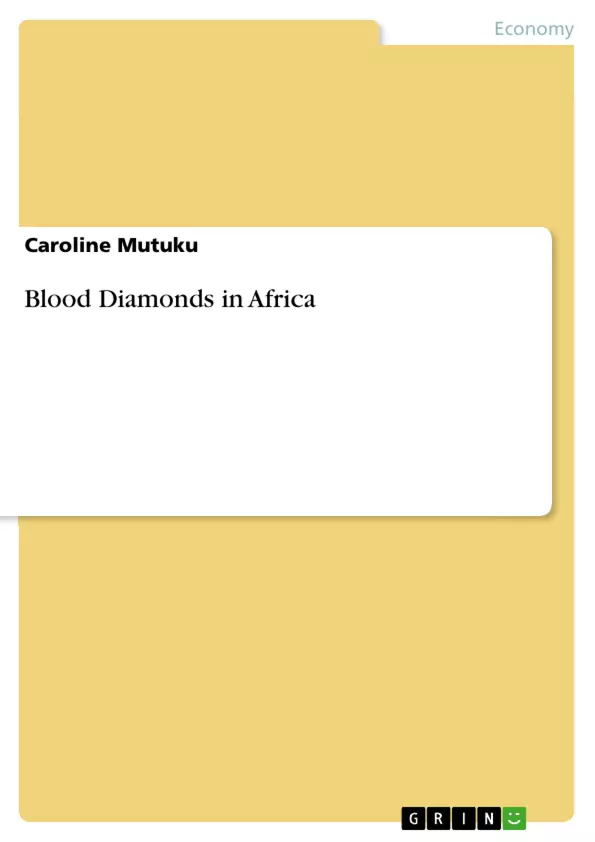In 2012, CNN broadcasted an analysis on how diamonds fuel conflicts in Africa. The story rose out of the trial of Charles Taylor, a former President of Liberia, at the International Court for crimes against humanity committed in Sierra Leone. The civil war in Sierra Leone was funded by the proceeds from the illegal sales of the alluvial diamonds found in Sierra Leone. The abundant natural resource was used to kill and main the people it should have benefited. The RUF rebel forces as well as the government forces committed horrendous atrocities against the people of Sierra Leone most of whom still live with the scars inflicted by the rebels. The gross human rights violation involved the amputations of arms, legs, noses and ears if the victim was suspected of corroborating with the government. The Liberian government was also culpable in the human rights violation for having supported the rebels with arms and logistics.
Table of Contents
- Abstract
- Introduction
- Human rights
- Human Rights Violation
- What are diamonds?
- Origin of Diamonds
- Blood Diamonds in Africa
- The problem of blood diamonds
- Non-Governmental Organizations involvement in diamonds
- The Kimberly process
- Sierra Leone and the blood diamonds
- The Conflict Background
- The Government Involvement in Diamonds and War
- Neighboring Countries Role in the Civil War
- Conclusion
Objectives and Key Themes
The paper examines the link between blood diamonds and human rights violations in Sierra Leone, specifically focusing on the civil war and its aftermath. It aims to shed light on the role of blood diamonds in financing rebel forces and the consequences of this illicit trade on the lives of ordinary citizens.
- The impact of blood diamonds on human rights
- The role of blood diamonds in fueling conflict in Sierra Leone
- The involvement of governments and rebel groups in the blood diamond trade
- The efforts of non-governmental organizations to address the issue of blood diamonds
- The history and origin of blood diamonds
Chapter Summaries
- Abstract: This section provides an overview of the paper's focus, highlighting the connection between the trial of Charles Taylor and the use of diamonds to finance conflicts in Africa. It introduces the devastating impact of the civil war in Sierra Leone, fueled by the illegal diamond trade.
- Introduction: The introduction delves into the background of the paper, drawing attention to the trial of Charles Taylor and the role of blood diamonds in the Sierra Leone conflict. It emphasizes the significance of the case and the role of Naomi Campbell's testimony in bringing attention to the issue.
- Human rights: This section explores the fundamental rights of individuals and the importance of their protection. It highlights the vulnerability of the poor and the challenges they face in upholding these rights, particularly in developing countries.
- Human Rights Violation: This section defines human rights violations as acts that infringe on the right to life, liberty, and integrity. It examines the specific forms of violence perpetrated during armed conflicts, focusing on the vulnerability of children, women, the disabled, and the elderly. The Women's Protocol is mentioned as a framework for protecting vulnerable groups.
- What are diamonds?: This section introduces diamonds as a mysterious and valuable gemstone, outlining their historical significance and cultural associations. It explores the beliefs surrounding diamonds, including their purported healing properties and the power to reconcile relationships.
Keywords
The primary focus of the paper centers around the concept of blood diamonds and their devastating impact on human rights in Sierra Leone. It delves into the relationship between conflict, illicit diamond trade, and the human rights violations that resulted from the Sierra Leone civil war. Key terms and concepts include blood diamonds, human rights violations, conflict diamonds, Sierra Leone civil war, rebel groups, government involvement, non-governmental organizations, and the Kimberly process. The paper also touches upon the role of international law and its efforts to address crimes against humanity.
- Citation du texte
- Caroline Mutuku (Auteur), 2018, Blood Diamonds in Africa, Munich, GRIN Verlag, https://www.grin.com/document/428835



